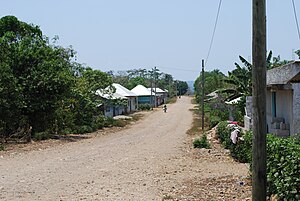Frontera Corozal, Chiapas
| Frontera Corozal | |
|---|---|

Residential street in the town
|
|
| Location in Mexico | |
| Coordinates: 16°49′16″N 90°53′25″W / 16.82111°N 90.89028°WCoordinates: 16°49′16″N 90°53′25″W / 16.82111°N 90.89028°W | |
| Country |
|
| State | Chiapas |
| Municipality | Ocosingo |
| Population (2010) | |
| • Total | 5,184 |
Frontera Corozal is a mostly Ch’ol community located in the Mexican state of Chiapas on the Usumacinta River, which separates it from neighboring Guatemala. The community was founded in the 1970s by families migrating from northern Chiapas. It is known for its dock with boats called lanchas which ferry people to the otherwise inaccessible Mayan ruins of Yaxchilan as well as to Bethel, Guatemala. It is also home to a regional museum, which is centered on two steles found nearby at Dos Caobas. The community is located in the Lacandon Jungle, surrounded by tropical rainforest, but this area has suffered severe damage. There have been recent efforts to promote conservation here, especially on communally owned lands. As of 2010, the town of Frontera Corozal had a population of 5,184.
Frontera Corozal is a community located in the Ocosingo municipality in the northeast of Chiapas. It is a border town, located on the banks of the Usumacinta River across from Bethel, Guatemala. The town was founded in 1976 by Ch’ol migrants from northern Chiapas along with a small number of Lacandon and Tzeltal families. Relations among the ethnicities are mostly tranquil. The town and the immediate area consist of nine neighborhoods with about 11,000 inhabitants. Basic services are concentrated in the center of town near the river. The town celebrates the Festival of Corn (Fiesta del Elote) in August as well as a ceremony to ask for rain in May at the Tsolkinse caverns.
The town is connected to Lacanja Chansayab, Chancalá and Palenque. It is connected to Palenque via Frontiza del Sur highway. The town is about 22 km off the Fronteriza highway. This drive used to be unsafe but security issues have significantly improved. There are vans that provide transportation to the docks from Palenque. The town was only connected to the rest of the country via paved roads in the mid-1990s, and most people use Guatemalan cell phones if they use phones at all, because the Mexican network does not reach here.
...
Wikipedia

